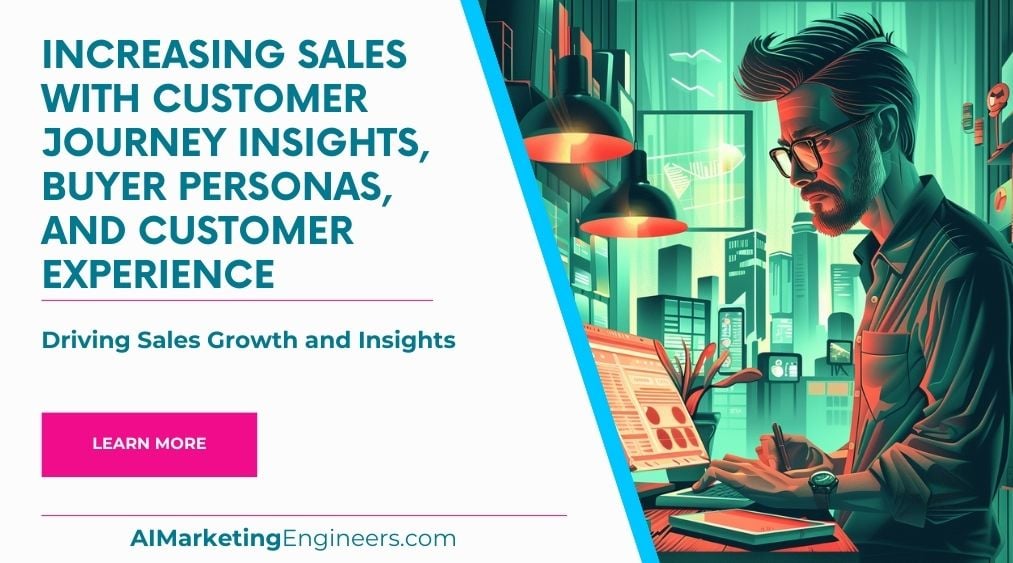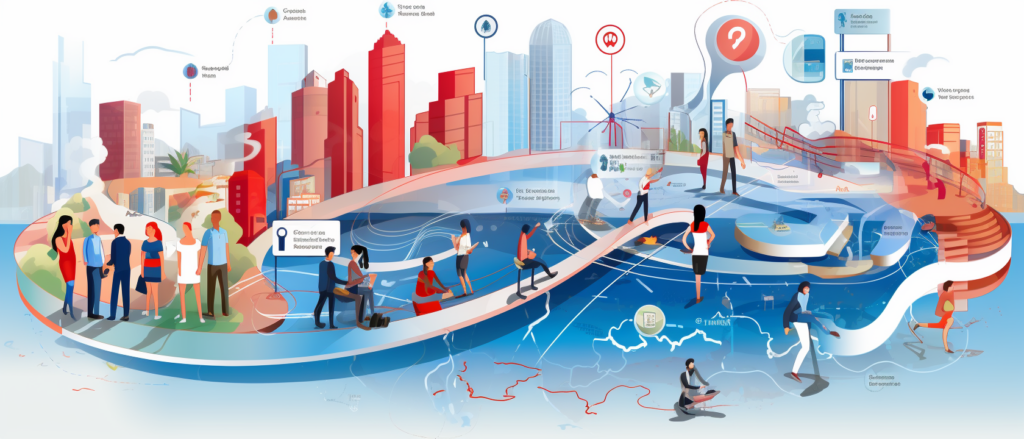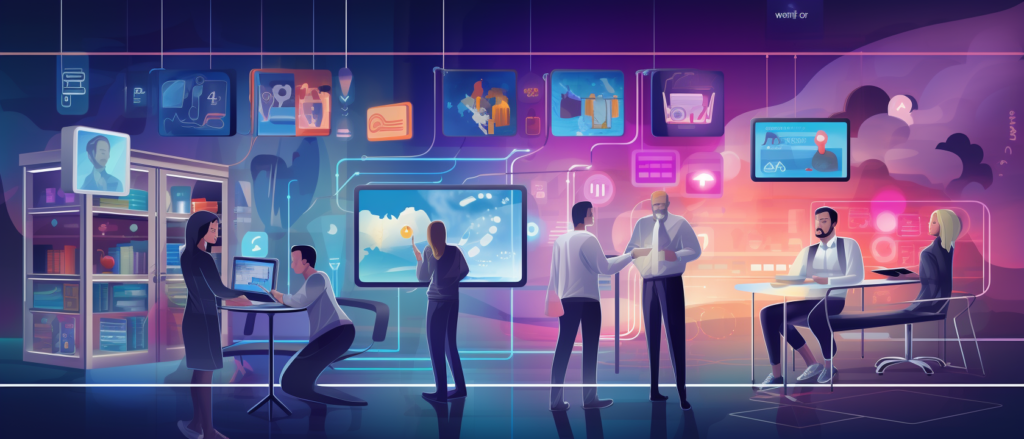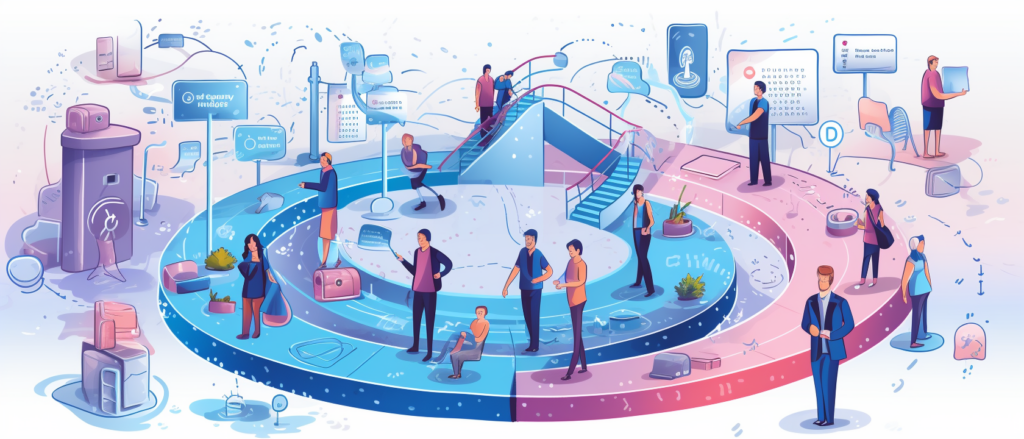Key Takeaways
✅ Understanding the Customer Journey: A staggering 86% of buyers are willing to pay more for a great customer experience. To capitalize on this, businesses must chart their customer's journey, taking a magnifying glass to each touchpoint and crafting an experience that not only meets but exceeds expectations.
✅ Personalized Customer Experiences: Did you know that businesses using advanced personalization report a $20 return for every $1 spent? That's right, tailoring the experience to individual needs isn't just nice, it's economically savvy. By addressing specific customer groups with specific solutions, sales can skyrocket.
✅ Collaboration and Data Sharing: Teams that communicate effectively see a 25% increase in performance. This means tearing down the walls between marketing and sales can lead to richer customer insights, better targeting, and a boost in sales figures.
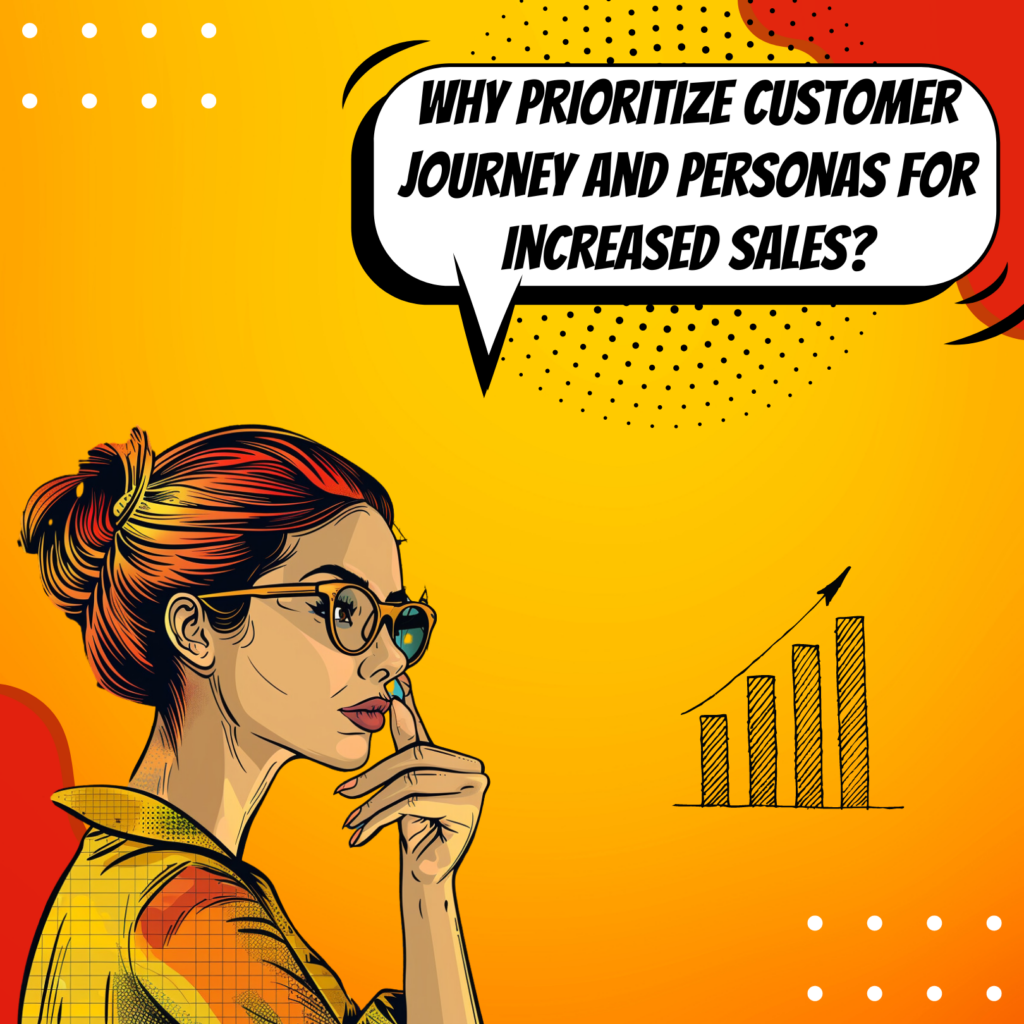
Introduction
Are you struggling to make your sales numbers climb? Often, the solution rests in three powerful words: Understanding the Customer Journey. It's the compass that guides shoppers from casual browsers to dedicated buyers, and it's crucial for any business aiming to thrive in a cluttered marketplace.
Creating Buyer Personas isn't just a game of guesswork; it's a deep dive into who your customers truly are. These aren't just statistics on a page—they're living, breathing people with unique preferences and pain points. By painting a vivid picture of their behaviors and desires, businesses can tailor a shopping experience that feels like it was made just for them.
Peek behind the curtain to discover how the perfect blend of Buyer Personals and Customer Experience maximizes revenue, optimizes return on ad spend (ROAS), and multiplies return on investment (ROI). Get ready to unlock a treasure trove of actionable insights that will not only enlighten you but also equip you with the latest techniques to make your numbers soar. Pour yourself a fresh cup of coffee, and prepare to rethink everything you know about sales—these aren't your average tips; they're your new sales bible.
Top Statistics
| Statistic | Insight |
|---|---|
| Customer Journey Mapping: Effective customer journey mapping can reduce the cost to service by 15-20%. | Mapping out the customer journey isn't just busywork. It directly ties into savings and efficiency, reducing costs substantially by focusing exactly where the customer needs support. |
| Buyer Personas: High-performing companies regularly update and maintain buyer personas, leading to a 100% increase in web page visits and 171% increase in marketing-generated revenue. | It’s not enough to guess who your buyers are. Companies that really understand their customers, and reflect that in their buyer personas, see web traffic and sales soar. |
| Positive Experiences: Positive customer experiences yield 20% higher customer satisfaction rates and a 10-15% boost in sales conversion rates. | Happy customers are your best marketers. A great experience does wonders, turning satisfaction into actual sales numbers. It's a clear win-win. |
| Persona Effectiveness: Buyer personas can result in a 111% increase in email open rate. | If your emails are getting lost in the void, it might be time to realign them with what your customers actually want to see, as shown by the huge leap in engagement with accurate personification. |
| Proactive Support: More than 85% of customers want proactive communication and contact from businesses. | Don’t wait for a customer to reach out with a problem. Being proactive is not just preferred, it's expected. Keep that dialogue open to build trust and loyalty. |
Understanding the Customer Journey
To truly uplift your sales numbers, it's essential to understand the customer journey. This entails more than just knowing when and where purchases happen. The real trick lies in comprehending the subtleties of how customers transition from unaware onlookers to loyal fans of your brand. But how does a business begin to unravel this journey? It starts with a clear outline of every point at which a customer encounters your brand—these are your critical touchpoints. Whether it's an ad, a product review, or customer service interaction, each of these moments can either inch your customer closer to a sale or push them away.
Creating Buyer Personas
Diving deep into the background of your customers to create a buyer persona can be a revealing exercise. It requires more than a surface-level glance at demographics; it's about analyzing behaviors, motivations, and those little everyday irritations your product or service could solve. If you get this right, you can tailor every marketing message to speak directly to your average customer's heart. Sometimes, you can even anticipate their needs before they fully realize them. This proactive approach can significantly enhance the relevance and impact of your marketing efforts. Ultimately, a well-crafted buyer persona serves as a blueprint for all your customer interactions.
Identifying Customer Touchpoints and Needs
Where do customers and prospects make contact with your brand, and more importantly, what do they need at these moments? By listing out these contact points—from social media to customer service calls—and actively seeking out feedback, you can begin to understand and improve these interactions. Do they need more information? Reassurance? A faster way to purchase? Answering these questions can lead to bolder, more effective strategies. Effective touchpoint management ensures that each customer encounter is optimized to meet their needs, enhancing overall satisfaction. This detailed approach helps in creating a seamless and positive customer journey.
Documenting the Customer Journey
Imagine creating a bird's eye view of the customer's pathway through your marketing and sales funnels. This is called customer journey mapping, and it involves careful documentation of the customer's emotions, behaviors, and motivations at each stage of their interaction with your brand. By mapping this, you reveal the truth behind their needs and how well your company satisfies them at each juncture. This visual representation helps in identifying gaps and opportunities for improvement. Consistent documentation and analysis can lead to significant enhancements in the customer experience. Regular updates to this map ensure it remains relevant as customer expectations evolve.
Continuously Reviewing and Improving the Customer-side Experience
The work doesn't stop once the map is made; the real challenge is to keep refining it. Regular reviews of the journey map using customer feedback and updated data give businesses the savviness to stay relevant and responsive. It's the brands that revisit and tweak their strategies regularly that stay ahead of the curve in providing a stellar customer journey. This continuous improvement mindset ensures that businesses remain aligned with their customers' evolving needs. Regularly updating and refining the journey map fosters a culture of excellence and innovation. Staying proactive in enhancing the customer experience is key to long-term success.
Optimizing the Customer Experience
Tools such as email marketing, retargeting ads, push notifications, and chatbots, when used skillfully, have the power to craft an optimized customer experience. Leveraging customer journey analytics ensures that brands are not just shooting in the dark but are delivering personalized experiences that resonate with the customer at every step. Effective use of these tools can significantly enhance customer satisfaction and loyalty. Analyzing data from these interactions provides insights into what works and what doesn't. This approach helps in fine-tuning strategies to better meet customer expectations. Ultimately, an optimized customer experience translates into higher conversion rates and increased sales.
AI Marketing Engineers Recommendation
Recommendation 1: Map Out the Customer Journey with Data-Driven Touchpoints: Dive into analytics to understand each stage of the customer journey: awareness, consideration, decision, and loyalty. Utilize tools like Google Analytics to identify where potential customers drop off and where they most engage. According to a Salesforce report, high-performing marketing teams are 8.8 times more likely to actively map the customer journey than underperformers. Integrating this data allows for targeted strategies that can smooth out pain points and better align offerings with customer needs, potentially boosting sales through a more personalized experience.
Recommendation 2: Create Dynamic Buyer Personas Using AI-Powered Insights: Forget static, one-dimensional buyer personas; today's technology allows for much more. Leverage AI and machine learning platforms to analyze customer data and social media behavior to build dynamic, multi-faceted personas that evolve with real-time insights. For example, IBM Watson Personality Insights can analyze textual data from your customer base to help you understand personality traits driving buyer behavior. This kind of deep, real-time understanding can lead to a customer experience that resonates on a personal level, thereby increasing conversion rates. It's not just about who your customers are, it's about why they make the decisions they do.
Recommendation 3: Optimize Customer Experience with Personalized Engagement Tools: Personalization is the key. Use tools like HubSpot or Salesforce to automate personalized email campaigns, product recommendations, and content delivery based on customer behavior and preferences. According to Epsilon, 80% of consumers are more likely to make a purchase from a brand that provides personalized experiences. By using these tools to harness data and insights from your buyer personas and customer journey analysis, you can offer a tailored experience at every touchpoint, boosting sales through understanding customer journey nuances and meeting individual needs head-on.
Relevant Links
- Step Inside WeChat: Your Ultimate Chinese Digital Marketing Guide
- Unlock the Power of Douyin & Kuaishou: China's Video Marketing Giants
- Boost Your Brand with South Korea's Video Marketing Secrets
- Conquer South Korean e-Commerce: Strategy Masterclass for Online Retailers
- Stay Ahead: Chinese Consumer Behavior Insights for 2024
Conclusion
When trying to boost sales, few strategies are more effective than delving deep into the customer journey. By meticulously crafting and continuously refining buyer personas, businesses gain a clear vantage point from which to view and understand the meandering paths their customers take from first contact to loyal advocacy. It's no secret that knowing your customer's behaviors, motivations, and challenges—not just superficial demographics—not only strengthens marketing strategies but also solidifies the brand-customer bond, encouraging retention and reducing churn.
Moreover, in a world awash with competition, companies that pinpoint crucial touchpoints, optimize interactions, and tailor the customer experience to individual needs stand out. They're the ones that leave a lasting, positive impression. Regular analysis and improvement of these touchpoints, along with the judicious use of analytics, lead to a deeper grasp of customer dynamics and, consequently, to service enhancements and product innovations that hit the mark. What becomes clear is that a customer journey isn't just a tool; it's a roadmap that leads to improved customer experiences and an increase in sales. But remember, this isn’t a “set it and forget it” process. It demands ongoing attention and adjustment, because as markets evolve, so do customer expectations.
To stay ahead, engage in continuous review and customer journey analytics—they're not just buzzwords, they are essential practices for success. Give life to your customer personas, make them the heart of every decision, and watch as the path to purchase becomes not just a transaction—but a meaningful relationship with your brand. This isn’t merely good business; it's the future of how products and services will be sold and cherished. So, take a fresh look at your customer journey today, and ask yourself whether it truly reflects the people you serve and if it guides them towards the outcomes that matter most to both of you.
FAQs
Question 1: What is a Customer Experience (CX) Persona?
Answer: A CX Persona is like a character in a story that represents your real-life customers. Think of it as the mask your customer wears - it shows you their hopes, their struggles, their day-to-day life, and what they expect from you.
Question 2: What is the difference between a CX Persona, a Buyer Persona, and an Avatar?
Answer: If a CX Persona is like the mask of a real customer, a Buyer Persona and an Avatar are like the masks for an 'ideal' customer. They're all about helping you sell more and market better. But the CX Persona? That one's all about making sure the overall experience with your company is top-notch.
Question 3: What are the stages of the customer journey?
Answer: Picture a road trip: from deciding where to go (Awareness) to looking up places to visit (Consideration), choosing the destination (Decision), having such a great time that you can't wait to go back (Retention), and telling all your friends about it (Advocacy). That's your customer journey, business style.
Question 4: How do you create a Customer Experience Persona?
Answer: It's like being a detective; gather clues (data) through talking to people, surveys, and team wisdom. Pinpoint why they came through your door, what they're trying to get done, and what makes them tick. Then, weave it all into a story that maps out every step of their adventure with you.
Question 5: What is the importance of customer feedback in customer journey mapping?
Answer: Feedback is your gold dust. It tells you where you're going wrong and where you're striking all the right chords. It comes in many forms - from the praise you get on a review site to the scores customers give your service. It's all about spotting the bumps on the road from a mile away.
Question 6: How can data analytics enhance customer welcome journey mapping?
Answer: Think of data analytics as your GPS. Tools like Google Analytics can help you see where your customers get lost or have a great time, and they let you reshape the journey so that it's smooth sailing from start to finish.
Question 7: Why is it essential to have a clear customer journey map?
Answer: Knowing the map means you can dodge the traffic jams and make sure your customers get where they're going with a smile on their face. It makes customers stick around, gets everyone on the same page, and lets you spot the potholes before your customers stumble.
Question 8: How can you use customer journey mapping to improve sales?
Answer: When you know the journey inside out, you can make sure everyone feels taken care of every step of the way. Happy customers become loyal ones, and that means more cha-ching for your business.
Question 9: What are the benefits of creating a customer journey map?
Answer: Well, apart from making your customers happier than kids in a candy store, it also helps keep them coming back for more. It boosts sales, makes everyone focus on giving customers what they actually want, and highlights where you can up your game.
Academic References
- HubSpot. Customer Journey Maps. In this insightful article, HubSpot dissects the customer journey mapping process and explains its critical role in enhancing the customer experience. The piece stands out for its detailed guidelines on crafting effective journey maps that take into account customer profiles and touchpoints. Source unavailable for in-depth exploration.
- Revenue Marketing Alliance. Improving the Customer Journey with Revenue Marketing. This article converges on the symbiotic relationship between revenue marketing and an improved customer journey. It emphasizes personalized experiences and the integration of marketing and sales efforts as key components for driving superior business results. Source unavailable for in-depth exploration.
- Ecwid. How to Increase Sales by Improving Customer Journey in Ecommerce. Focused on the ecommerce domain, this article underlines the strategic importance of a well-mapped customer journey. It suggests actionable steps to outline buyer personas, identify customer interactions and constantly refine the journey map driven by customer feedback and behavior. Source unavailable for in-depth exploration.
- Close. Customer Journey Mapping. Close's comprehensive article walks readers through the stages of the customer journey, from awareness to advocacy. It accentuates the need for tailored journey maps across distinct customer segments to effectively address their unique necessities. Source unavailable for in-depth exploration.
- Experience Investigators. How to Build a Customer Experience Persona. Detailing the process of developing customer experience personas, this article addresses the imperative of grasping customer motivations and pain points. It serves as a primer on creating detailed personas that capture the essence of customer segments. Source unavailable for in-depth exploration.
